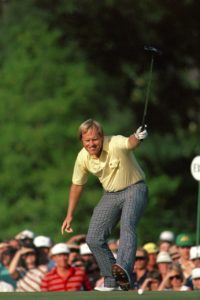The Greatest Masters Ever
0By Scott MacLean
The Masters gets underway at Augusta National tomorrow morning, with Dustin Johnson looking to retain the Green Jacket he won only a few short months ago in November’s Covid-delayed 2020 edition. But chasing him will be a host of players including a rejuvenated former winner in Jordan Speith, Spaniard Jon Rahm looking for his first major, Ulsterman Rory McIlroy trying to defy his recent form and complete the career Grand Slam, and Bryson DeChambeau who might try to hit it over every tree on the property.
But it’s also the 35th anniversary of the Greatest Masters Sunday Ever.
————————————————————————————————————————-
1986. The West and East faced off in the Cold War, though through Reagan and Gorbachev it was starting to thaw. Thatcher had her iron grip on the UK, and France under Mitterand were still testing nukes in the Pacific at Mururoa. Here, New Zealand was getting to grips with Roger Douglas’ economic reforms and while we’d just trounced the Aussies in the cricket over there, their rugby players were about to come here and take the Bledisloe home with them.
When it came to golf, woods were still mainly made of that, irons had a sweetspot the size of a pencil head, and the ball was made of rubber bands covered in the sap of a tree (yes, really).
As the fourth round started, Greg Norman sat atop a star-studded leaderboard at six-under. Alongside him in the final pair would be Zimbabwean Nick Price, who had barely made the cut before scorching Augusta on Saturday for a course-record nine-under 63. In the group ahead was the defending champion Bernhard Langer, and the two pairs ahead of that comprised two-time winner Seve Ballesteros and Tom Kite, and another two-time champion in Tom Watson alongside Japanese star Tommy Nakajima. And in front of them would be British Open champion Sandy Lyle, and the 46-year-old five-time Masters winner Jack Nicklaus.
Matters started slowly, several players birdied the Par-5 second to pick up a shot on Norman who could only manage a par there. But it heated up quickly when Ballesteros birdied the seventh followed by both he and Kite holing their approach shots into the Par-5 eighth for eagle 3’s; remarkably and inexplicably neither shot was broadcast or even recorded because the cameraman was on a break at the time!
The old adage is that the Masters “doesn’t start until the back nine on Sunday” and as Norman made the turn he was tied for the lead with Ballesteros and one ahead of Kite. But ahead the roars were building, as Nicklaus had birdied 9, 10, and 11 to close to within two before dropping a shot at the famed 12th.
Norman was the first to blink, yanking his second into 10 way left and winding up with an ugly double-bogey six that put a large spanner into his chances. Especially when Ballesteros hit an exquisite second into the picturesque Par-5 13th and holed the putt for his second eagle of the round to leap to 9-under and two ahead of Kite. And surely it was now the mercurial Spaniard’s tournament to lose.
But then the fun started. Standing at the top of the hill on 15, Nicklaus rifled his second across the pond and within 15 feet of the cup, sinking that putt for an eagle 3 and kicking off another of the famed Augusta roars. He was even better on 16, almost making a hole-in-one, but the birdie put him one back of Ballesteros who could see what was happening from his vantage point up the hill on 15. But rather than emulate his pursuer Seve cracked, hitting an ugly pull-hook that found the water and resulting in a bogey 6 that dropped him back into a tie with Nicklaus and Kite, who had birdied 15.
Nicklaus was left off the tee at 17, but hit his second to within 20 feet. After picking the line with the help of his caddy – eldest son Jackie – he holed the putt to take sole possession of the lead for the first time all week. That image of Nicklaus following the ball in, raising the oversized putter he was using that week above his head as the crowd roars and accompanied by commentator Verne Lundquist’s “Maybe…… YES SIR!!!” call remains one of the iconic moments in Masters history.
Nicklaus would make par at 18 to finish at nine-under, shooting a 65 for the day and a scarcely believable six-under 30 for the back nine. Behind him the challengers would come up short; Kite missed an opportunity for birdie at the last, Ballesteros would drop another shot at 17, and brief flurries by Watson and Price only got them so close.
But there was still one man out there that could end the fairytale. Having drifted out of the picture after his disaster at 10, Norman had roared back into contention by rattling off successive birdies at 14, 15, and 16 to be one behind, but had pulled his tee shot well left on 17. But he conjured up a miraculous recovery, threading the ball between two trees to just eight feet, and after sinking the putt was tied with Nicklaus. But after hitting a perfect drive on 18, he fanned his second right into the gallery and failed to get down from there for par, giving Nicklaus his sixth Green Jacket and 18th Major in all (as well as setting in train his own history of Major disappointments).
(You can watch the whole final round here)
Will we see something approaching this this year come Monday morning? We can only but hope.

